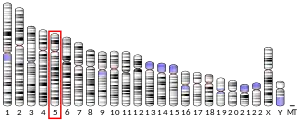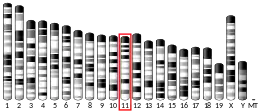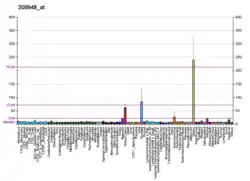KCNMB1
Calcium-activated potassium channel subunit beta-1 is a protein that in humans is encoded by the KCNMB1 gene.[5][6][7]
Function
MaxiK channels are large conductance, voltage and calcium-sensitive potassium channels which are fundamental to the control of smooth muscle tone and neuronal excitability. MaxiK channels can be formed by 2 subunits: the pore-forming alpha subunit and the product of this gene, the modulatory beta subunit. Intracellular calcium regulates the physical association between the alpha and beta subunits.[7] Beta subunits (beta 1-4) are highly tissue specific in their expression, with beta-1 being present predominantly on vascular smooth muscle. Endothelial cells are not known to express beta-1 subunits. Beta-1 is also known to be expressed in urinary bladder and in some regions of the brain. Association of the beta-1 subunit with the BK channel increases the apparent Ca2+ sensitivity of the channel and decreases voltage dependence.[8]
References
- GRCh38: Ensembl release 89: ENSG00000145936 - Ensembl, May 2017
- GRCm38: Ensembl release 89: ENSMUSG00000020155 - Ensembl, May 2017
- "Human PubMed Reference:". National Center for Biotechnology Information, U.S. National Library of Medicine.
- "Mouse PubMed Reference:". National Center for Biotechnology Information, U.S. National Library of Medicine.
- Tseng-Crank J, Godinot N, Johansen TE, Ahring PK, Strøbaek D, Mertz R, Foster CD, Olesen SP, Reinhart PH (Aug 1996). "Cloning, expression, and distribution of a Ca(2+)-activated K+ channel beta-subunit from human brain". Proceedings of the National Academy of Sciences of the United States of America. 93 (17): 9200–5. doi:10.1073/pnas.93.17.9200. PMC 38619. PMID 8799178.
- Jiang Z, Wallner M, Meera P, Toro L (Jan 1999). "Human and rodent MaxiK channel beta-subunit genes: cloning and characterization". Genomics. 55 (1): 57–67. doi:10.1006/geno.1998.5627. PMID 9888999.
- "Entrez Gene: KCNMB1 potassium large conductance calcium-activated channel, subfamily M, beta member 1".
- Tano, J.-Y.; Gollasch, M. (2014). "Hypoxia and ischemia-reperfusion: a BiK contribution?". AJP: Heart and Circulatory Physiology. 307 (6): H811–H817. doi:10.1152/ajpheart.00319.2014. ISSN 0363-6135. PMID 25015960.
Further reading
- Orio P, Rojas P, Ferreira G, Latorre R (Aug 2002). "New disguises for an old channel: MaxiK channel beta-subunits". News in Physiological Sciences. 17 (4): 156–61. doi:10.1152/nips.01387.2002. hdl:10533/173696. PMID 12136044.
- Knaus HG, Folander K, Garcia-Calvo M, Garcia ML, Kaczorowski GJ, Smith M, Swanson R (Jun 1994). "Primary sequence and immunological characterization of beta-subunit of high conductance Ca(2+)-activated K+ channel from smooth muscle". The Journal of Biological Chemistry. 269 (25): 17274–8. PMID 8006036.
- Meera P, Wallner M, Jiang Z, Toro L (Mar 1996). "A calcium switch for the functional coupling between alpha (hslo) and beta subunits (KV,Ca beta) of maxi K channels". FEBS Letters. 382 (1–2): 84–8. doi:10.1016/0014-5793(96)00151-2. PMID 8612769. S2CID 81684849.
- Dworetzky SI, Boissard CG, Lum-Ragan JT, McKay MC, Post-Munson DJ, Trojnacki JT, Chang CP, Gribkoff VK (Aug 1996). "Phenotypic alteration of a human BK (hSlo) channel by hSlobeta subunit coexpression: changes in blocker sensitivity, activation/relaxation and inactivation kinetics, and protein kinase A modulation". The Journal of Neuroscience. 16 (15): 4543–50. doi:10.1523/JNEUROSCI.16-15-04543.1996. PMC 6579031. PMID 8764643.
- Valverde MA, Rojas P, Amigo J, Cosmelli D, Orio P, Bahamonde MI, Mann GE, Vergara C, Latorre R (Sep 1999). "Acute activation of Maxi-K channels (hSlo) by estradiol binding to the beta subunit". Science. 285 (5435): 1929–31. doi:10.1126/science.285.5435.1929. PMID 10489376.
- Meera P, Wallner M, Toro L (May 2000). "A neuronal beta subunit (KCNMB4) makes the large conductance, voltage- and Ca2+-activated K+ channel resistant to charybdotoxin and iberiotoxin". Proceedings of the National Academy of Sciences of the United States of America. 97 (10): 5562–7. doi:10.1073/pnas.100118597. PMC 25868. PMID 10792058.
- Jin P, Weiger TM, Wu Y, Levitan IB (Mar 2002). "Phosphorylation-dependent functional coupling of hSlo calcium-dependent potassium channel and its hbeta 4 subunit". The Journal of Biological Chemistry. 277 (12): 10014–20. doi:10.1074/jbc.M107682200. PMID 11790768.
- Greenwood IA, Miller LJ, Ohya S, Horowitz B (Jun 2002). "The large conductance potassium channel beta-subunit can interact with and modulate the functional properties of a calcium-activated chloride channel, CLCA1". The Journal of Biological Chemistry. 277 (25): 22119–22. doi:10.1074/jbc.C200215200. PMID 11994272.
- Gollasch M, Tank J, Luft FC, Jordan J, Maass P, Krasko C, Sharma AM, Busjahn A, Bähring S (May 2002). "The BK channel beta1 subunit gene is associated with human baroreflex and blood pressure regulation". Journal of Hypertension. 20 (5): 927–33. doi:10.1097/00004872-200205000-00028. PMID 12011654. S2CID 88440283.
- Jin P, Weiger TM, Levitan IB (Nov 2002). "Reciprocal modulation between the alpha and beta 4 subunits of hSlo calcium-dependent potassium channels". The Journal of Biological Chemistry. 277 (46): 43724–9. doi:10.1074/jbc.M205795200. PMID 12223479.
- Mazzone JN, Kaiser RA, Buxton IL (2003). "Calcium-activated potassium channel expression in human myometrium: effect of pregnancy". Proceedings of the Western Pharmacology Society. 45: 184–6. PMID 12434576.
- Kudlacek PE, Pluznick JL, Ma R, Padanilam B, Sansom SC (Aug 2003). "Role of hbeta1 in activation of human mesangial BK channels by cGMP kinase". American Journal of Physiology. Renal Physiology. 285 (2): F289-94. doi:10.1152/ajprenal.00046.2003. PMID 12670831.
- Qian X, Magleby KL (Aug 2003). "Beta1 subunits facilitate gating of BK channels by acting through the Ca2+, but not the Mg2+, activating mechanisms". Proceedings of the National Academy of Sciences of the United States of America. 100 (17): 10061–6. doi:10.1073/pnas.1731650100. PMC 187764. PMID 12893878.
- Ransom CB, Liu X, Sontheimer H (Jun 2003). "Current transients associated with BK channels in human glioma cells". The Journal of Membrane Biology. 193 (3): 201–13. doi:10.1007/s00232-003-2019-7. PMID 12962281. S2CID 20169684.
- Hartness ME, Brazier SP, Peers C, Bateson AN, Ashford ML, Kemp PJ (Dec 2003). "Post-transcriptional control of human maxiK potassium channel activity and acute oxygen sensitivity by chronic hypoxia". The Journal of Biological Chemistry. 278 (51): 51422–32. doi:10.1074/jbc.M309463200. PMID 14522958.
- Fernández-Fernández JM, Tomás M, Vázquez E, Orio P, Latorre R, Sentí M, Marrugat J, Valverde MA (Apr 2004). "Gain-of-function mutation in the KCNMB1 potassium channel subunit is associated with low prevalence of diastolic hypertension" (PDF). The Journal of Clinical Investigation. 113 (7): 1032–9. doi:10.1172/JCI20347. PMC 379324. PMID 15057310.
- Leo MD, Bannister JP, Narayanan D, Nair A, Grubbs JE, Gabrick KS, Boop FA, Jaggar JH (Feb 2014). "Dynamic regulation of β1 subunit trafficking controls vascular contractility". Proceedings of the National Academy of Sciences of the United States of America. 111 (6): 2361–6. doi:10.1073/pnas.1317527111. PMC 3926029. PMID 24464482.
- Kuntamallappanavar G, Toro L, Dopico AM (2014). "Both transmembrane domains of BK β1 subunits are essential to confer the normal phenotype of β1-containing BK channels". PLOS ONE. 9 (10): e109306. doi:10.1371/journal.pone.0109306. PMC 4183656. PMID 25275635.
This article incorporates text from the United States National Library of Medicine, which is in the public domain.




